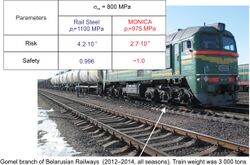Physics:Ductile iron with special properties
Ductile Iron with special properties is a form of malleable cast iron (DITG type - ductile iron developed by S&P Group TRIBOFATIGUE Ltd and JSC Gomselmash) which possess a complex of high mechanical properties: strength and plasticity, crack and contact fatigue resistance, self-lubrication at friction and ability to dampen the dynamic loading. The following specific feature can be seen in the "strength vs plasticity" diagram: plasticity increases with the increase in strength. Such properties can be explained by the balanced chemical composition with an optimal ratio of three modifying elements: Mo-Ni-Cu (that's why the DITG material is called MONICA) and are assured by the corresponding microstructure which is obtained by the respective heat treatment.
Chemical composition
The chemical composition corresponds to high-strength cast iron with spherical graphite (DI, ADI), but with the total carbon equivalent of about СE = 5.0 … 5.5. For three elements (Mo-Ni-Cu) this equivalent is equal to СE(3) = 0.35…0.45.
Microstructure
Depending on the heat treatment modes, the microstructure characteristic of ADI is obtained; it possesses the following specific feature: under certain conditions molybdenum evolutions are formed.
Mechanical properties
At strength limit σu~1300…1400 MPa the plasticity reaches the values of 3…5 %. Critical coefficient of intensity of stresses is equal to Kc=60…75 MPa[math]\displaystyle{ \sqrt[2]{m} }[/math] at σu=1100…1200 MPa. The contact fatigue limit (under the conditions of initial point contact) is pf=3750 MPa based on the tests of 108 cycles. High resistance to fatigue is explained by the fact that modification with molybdenum is more effective than the one with nickel and copper: in order to obtain the steel bending fatigue limit with rotation of σ−1=150 MPa, the amount of nickel shall be approximately 10 times higher than the amount of molybdenum.
Wear resistance
MONICA displays high self-lubrication properties since its microstructure contains graphite, molybdenum and copper. Availability of these elements helps to reduce the coefficient of friction for MONICA to ~50…70 % (as compared to steel) and to decrease the wear to ~30…50 %.
Application
The material is used to manufacture the parts of critical heavily loaded tribo-fatigue systems (see, for example, Figure 1).[1][2][3][4][5]
References
- ↑ Rundman, K. B., Moore, D. J., Hayrynen, K. L., Dubensky, W. J., & Rouns, T. N. (1988). The Microstructure and Mechanical Properties of Austempered Ductile Iron. J. Heat Treat., 5(2), 79-85. Retrieved May 23, 2019.
- ↑ Sosnovskiy, L. A. Iron and steel in tribo-fatigue systems of modern machinery and equipment / L. A. Sosnovskiy, P. A. Vityaz, V. A. Gapanovich, N. V. Psyrkov, N. A. Makhutov // Mechanics of machines, mechanisms and materials. – 2014. – № 4 (29). – P. 5–20. (In Russian).
- ↑ Sosnovskiy, L. A. Experimental construct a complete pair «VCHTG ductile iron / steel 18HGT» rolling fatigue curve and its analysis / L. A. Sosnovskiy, V. V. Komissarov, E. S. Taranova, S. A Tyurin // Mechanics of machines, mechanisms and materials. – 2014. – № 1 (26). – P. 32–39. (In Russian).
- ↑ Sosnovskiy, L. A. New structural material for railway rails: mechanical and service properties / L. A. Sosnovskiy, V. V. Komissarov, V. I. Matvetsov, N. E. Miroshnikov // Bulletin of BelSUT. – 2014. – № 2 (29). – P. 77–82. (In Russian).
- ↑ Komissarov, V. V. On the experience of manufacturing and operation of gears from the new structural material «MONICA» / V. V. Komissarov, E. S. Taranova, P. S. Drobyshevskiy, V. O. Zamyatnin, S. A. Tyurin, L. A. Sosnovskiy // Bulletin of IzhGTU name M. T. Kalashnikov. – 2017. – V. 20. – № 2. – P. 107–112. (In Russian).


